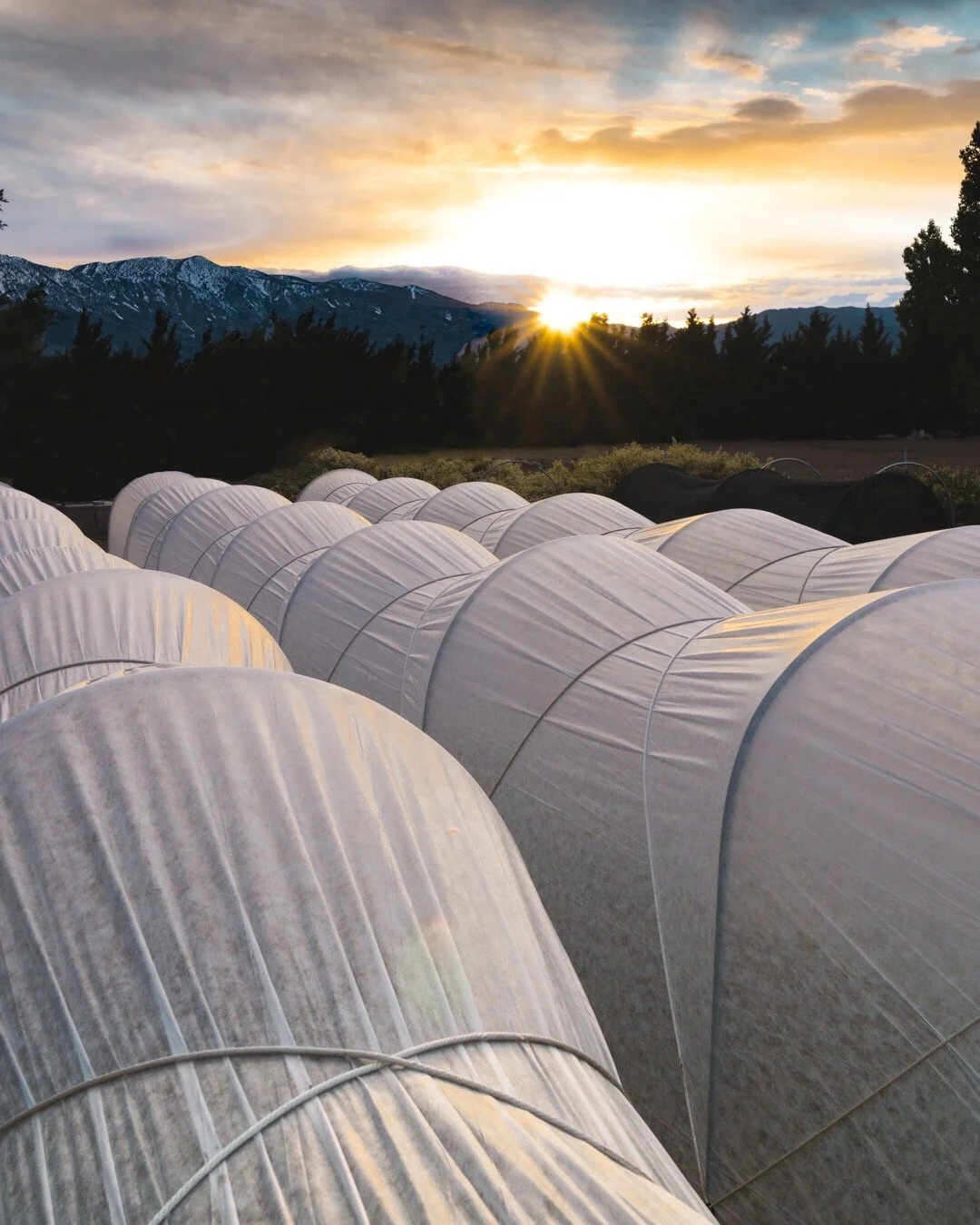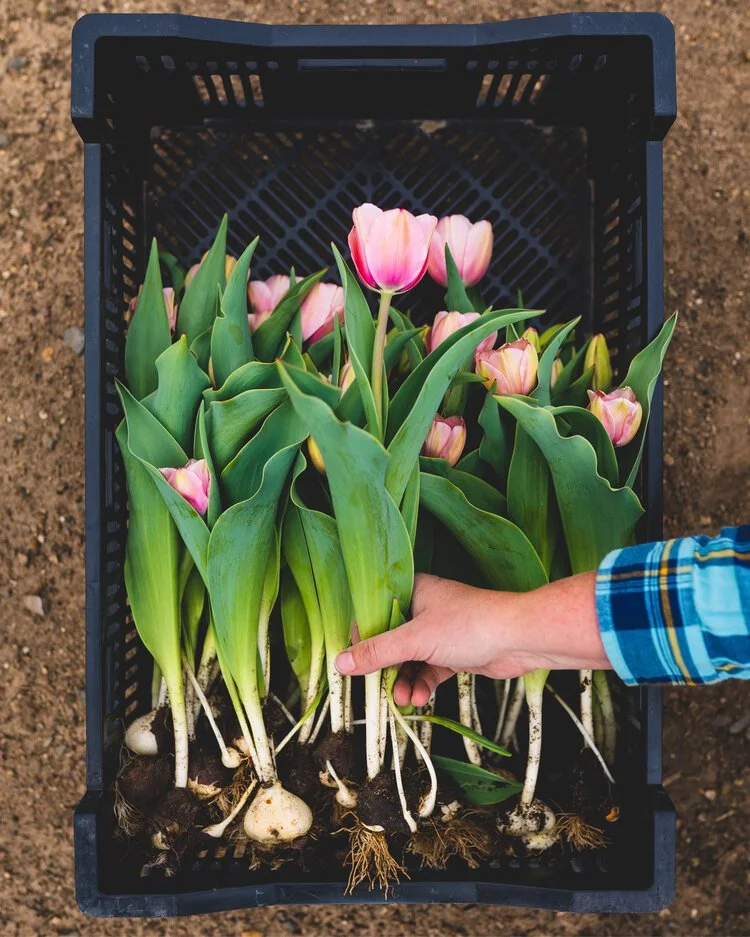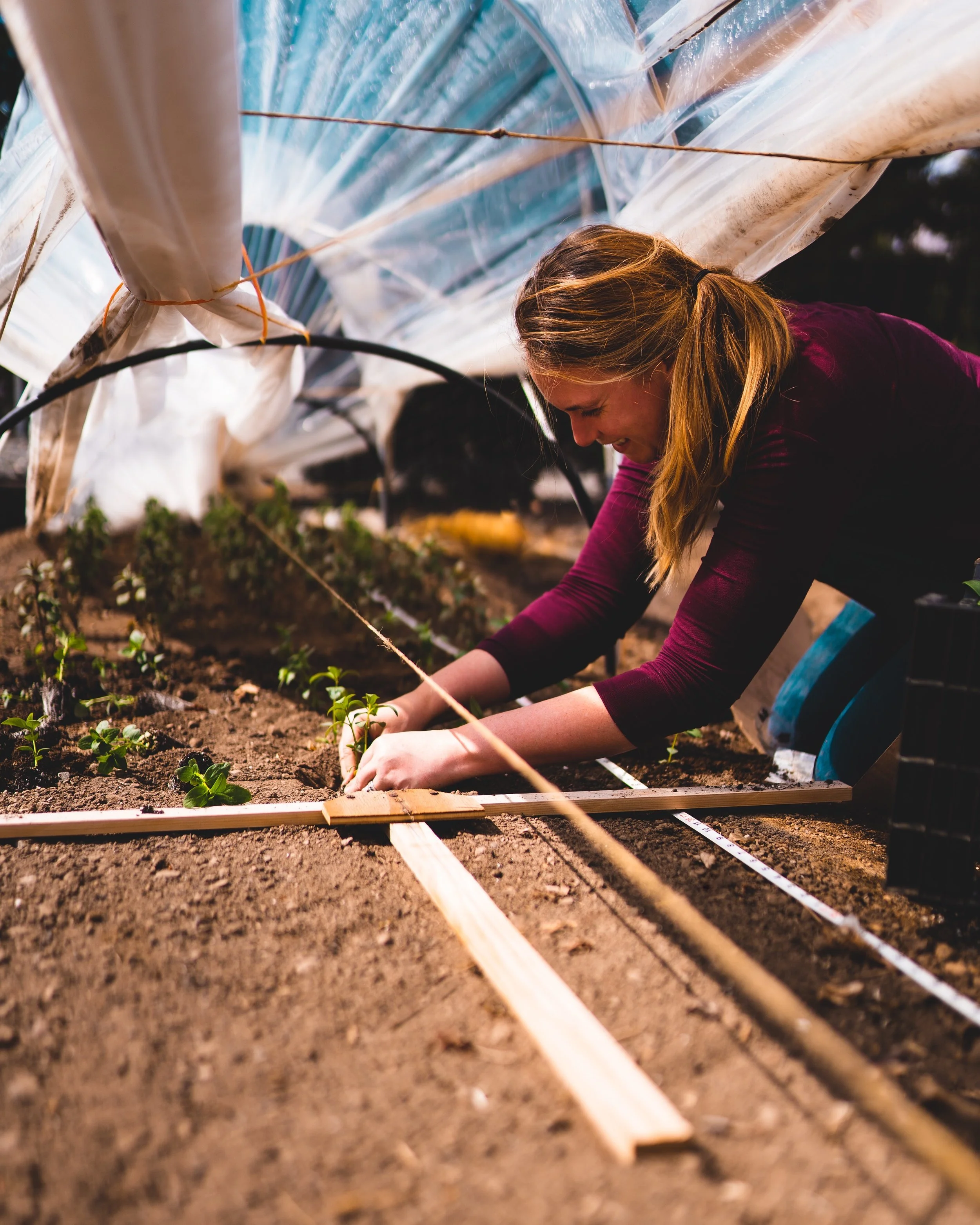Season Extension Guide: Unlocking the Potential of Spring and Fall Flower Farming
For flower farmers, the boundaries of spring and fall—those unpredictable "shoulder seasons"—offer incredible potential. These transitional periods, where the last frost hasn’t quite let go or the first frost is creeping in, can be the key to maximizing profitability and growing your business. But the challenges are real: freezing winds, volatile temperatures, and crops teetering on survival.
With season extension methods like low tunnels, frost cloths, and strategic planting, you can transform these high-risk periods into some of the most rewarding times of the year. Not only can you meet high consumer demand for blooms in spring and fall, but you can also extend your selling season, secure premium prices, and stand out in your market.
In this guide, we’ll cover everything you need to know about pushing the boundaries of flower farming through season extension:
What shoulder seasons are and why they matter.
Proven methods to protect and extend your crops.
Tips for balancing risk and profitability.
The best crops for early and late-season success.
Whether you're just starting out or looking to refine your approach, this guide will equip you with the tools and insights needed to thrive in the "off-season." Let’s get growing!
Note: This post contains affiliate links. If you make a purchase through these links, I may earn a small commission at no additional cost to you. Thank you for supporting our farm!
Unused low tunnels standing resilient against the snowy backdrop of winter, awaiting the next season's planting.
Unlocking the Potential of Shoulder Seasons
Shoulder seasons—those transitional times in early spring and late fall—are pivotal opportunities for flower farmers to extend their growing and selling seasons. These periods may not offer the same consistent weather as summer, but with the right strategies, they can become some of your most profitable times.
In our high desert climate, where temperatures swing wildly between extremes, mastering these seasons is essential. One day can feel like summer, while the next reminds us that winter isn’t ready to let go. These unpredictable conditions require adaptability, creativity, and the willingness to take calculated risks.
Why Focus on Shoulder Seasons?
Higher Market Demand: Spring and fall often see increased interest in flowers for weddings, Mother’s Day, graduations, and late-season events.
Reduced Competition: During these periods, fewer growers have blooms to sell, making your flowers more valuable.
Customer Loyalty: Offering blooms when others can’t which helps you stand out and keeps your customers returning season after season.
The Challenges of Shoulder Seasons
Frost Risks: Both spring and fall are susceptible to unexpected frosts that can damage or kill crops.
Labor-Intensive: Protecting crops during these volatile times requires more effort, from building and maintaining tunnels to frequent monitoring.
Emotional and Financial Investment: Taking the leap to grow in these seasons means accepting the possibility of crop loss, which can be nerve-wracking for any grower.
Strategies for Success
By investing in season extension methods and choosing crops suited to cooler temperatures, you can make the most of these periods. Whether it’s starting seedlings indoors earlier, using low tunnels to protect crops, or strategically scheduling successions, shoulder seasons can be a game-changer for your flower farm.
Pro Tip: Identifying hardy and tender annuals is key to planning your shoulder season crops. Learn more about frost dates, soil temperatures, and the growing requirements of your flowers in our blog, When to Plant: Frost Dates, SoilTemps, and Timing for Flower Farmers.
Crafting DIY low tunnel hoops with a homemade hoop bender, combining resourcefulness and practicality to extend the growing season.
Season Extension Methods Overview
Season extension methods allow flower farmers to bridge the gap between traditional growing seasons, maximizing production during the volatile shoulder months. These tools and techniques protect crops from unpredictable weather and create microclimates for earlier blooms or prolonged harvests.
Here are the most effective methods to consider:
Low Tunnels: Simple structures built with hoops and covered with frost cloth or greenhouse plastic, insulating crops from frost and wind. Perfect for spring crops like ranunculus or getting a head start on warm-loving crops like dahlias.
Caterpillar Tunnels: Taller than low tunnels, they offer improved airflow and height for larger crops while regulating temperature.
Double Tunnels: Combine low tunnels with an additional layer of frost cloth and plastic for extra insulation in extreme cold.
Cold Frames or Unheated Greenhouses: Passive solar structures that capture sunlight, ideal for overwintering hardy crops or starting transplants earlier.
Shade Cloth: Extends bloom windows in spring by protecting crops like ranunculus and sweet peas from unseasonable heat.
Programmable Crops: Using tulips or other programmed bulbs to stagger harvest windows.
Holding Flowers in Coolers: Extends the vase life of late-season blooms like dahlias and heirloom mums for weddings or events.
Pro Tip: Start small with simpler methods, such as low tunnels or frost cloth, and scale up to caterpillar tunnels or high tunnels as you build confidence and meet market demand.
By integrating these strategies, you can extend your growing and selling seasons by weeks—or even months—while ensuring greater crop survival during unpredictable weather.
Harvesting pastel tulips from protected rows under micro-tunnels, bridging spring's early days to market-ready blooms.
Exploring Season Extension Tools in Depth
Each of these methods has its unique applications and benefits. In the following sections, we’ll dive deeper into how you can apply them effectively to extend your growing and selling seasons.
1. Micro Tunnels
Made from bent top rail wire (available in the chainlink fencing section of hardware stores) and covered with frost cloth, micro tunnels are versatile tools for protecting crops and fresh transplants throughout the growing season.
Ideal Crops: Ranunculus, anemones, larkspur, snapdragons, root vegetables, lettuce, and newly planted transplants.
Application:
Spring/Fall: Keep crops and transplants covered to insulate against frosty nights or cold snaps. Frost cloth helps maintain consistent soil temperatures, protecting delicate root systems and encouraging steady growth.
Summer: Use lightweight frost cloth to reduce heat stress on fresh transplants and cool-season crops. Properly selected frost cloth can shield plants from excessive sun exposure while ensuring airflow.
Multi-Season: Micro tunnels are excellent for warming soil in early spring and cooling it in summer, providing a balanced environment for both established crops and new plantings.
Pro Tip: For year-round versatility, we recommend using 0.5-ounce frost cloth. This weight provides excellent protection for most conditions without overheating crops. For extra insulation during colder periods, double up the frost cloth or combine it with greenhouse plastic for added coverage.
Low tunnels at sunset provide protection against frost, extending the growing season for cool-weather crops.
3. Low Tunnels and Caterpillar Tunnels
Low tunnels and caterpillar tunnels are versatile season extension tools that can be adapted for a wide range of crops and conditions. These structures, whether DIY or from a kit, are invaluable for managing unpredictable shoulder seasons and protecting crops from temperature fluctuations, wind, and pests.
Caterpillar Tunnels vs. Low Tunnels
Caterpillar Tunnels: Larger structures that can cover multiple rows at once. These tunnels often use bent hoops and are secured with greenhouse plastic and tension ropes. They are ideal for farmers looking to protect larger plots or extend the season for multiple crops at once.
Low Tunnels: Smaller and more focused, these tunnels typically cover a single row or specific crops. They can be easily constructed using conduit, a hoop bender, and your choice of covering material.
Covering Options and Applications
One of the key benefits of these tunnels is the flexibility to switch coverings based on the season and crop requirements:
Frost Cloth: Provides insulation during early spring or late fall, protecting crops from frost damage. It is especially useful for crops like peonies, helping to protect buds and flower heads from late spring frosts.
Greenhouse Plastic: Offers warmth and wind protection during colder months or late winter plantings.
Shade Cloth: Helps cool crops during late spring and summer, preventing heat stress and bolting.
Netting: Protects plants from insect pressure and harsh weather while allowing air circulation.
Applications
Spring Plantings: Caterpillar tunnels are excellent for covering early-season crops like ranunculus, anemones, and Iceland poppies. Low tunnels are often used for transplant protection or more targeted coverage, such as shielding peonies from late frosts.
Summer Transplants: Shade cloth over low tunnels helps protect newly planted crops during hot summer months, preventing transplant shock.
Peonies: Frost cloth under low tunnels provides essential protection to peony buds and blooms during unpredictable late spring frosts, ensuring high-quality stems for markets and events.
DIY vs. Kits:
DIY Low Tunnels: Cost-effective and customizable, DIY tunnels can be built using conduit and a hoop bender. They’re perfect for farmers looking for specific dimensions or flexibility in materials.
Caterpillar Tunnel Kits: Pre-made kits are easier to assemble and often come with features like tension ropes for added stability in windy conditions. These are a great option for growers needing to cover large plots efficiently.
Why We Rely on Tunnels
We use tunnels year-round for various crops and conditions. In early spring, they protect cold-hardy crops like ranunculus, anemones, and peonies. In the heat of summer, shade cloth over low tunnels ensures transplants establish successfully. By fall, tunnels extend our harvest window, giving us marketable blooms like lisianthus and dahlias beyond the first frost.
Find reliable tools and materials for low tunnels and caterpillar tunnels, including frost cloth, greenhouse plastic, and hoop benders, here.
Layered protection inside a double low-tunnel ensures crops thrive even during extreme cold snaps.
3. Double Low Tunnels
Double-low tunnels combine the benefits of micro tunnels and caterpillar tunnels, offering an extra layer of insulation and protection for crops during harsh weather. This method is particularly valuable in areas with high winds, heavy snowfall, or extreme temperature fluctuations, as it provides greater stability and temperature control than micro-tunnels or caterpillar tunnels on their own.
Ideal Crops: Ranunculus, anemones, Iceland poppies, and other cold-hardy crops planted in late winter or early spring.
Application:
Layering: Use frost cloth as the first layer closest to the crops for insulation, then cover with greenhouse plastic to trap heat and provide additional protection against wind, snow, and rain.
Ventilation: On sunny or warmer days, easily lift the plastic layer to vent the tunnels and prevent overheating or condensation buildup. Proper airflow minimizes the risk of fungal diseases and encourages healthy growth.
Durability: Double-low tunnels are especially sturdy, making them a reliable option for regions with high winds or heavy snowfall. The dual-layer approach helps to maintain soil temperatures and reduce freezing and thawing cycles that can harm sensitive corms like ranunculus and anemones.
Additional Benefits:
This method creates a controlled environment where crops can focus on root development during cooler months, setting the stage for faster and healthier growth when temperatures rise. Double low tunnels also provide flexibility—on milder days, one or both layers can be removed to adjust to changing weather conditions. Once plants are established and tall enough, the micro-tunnel is easily removed.
For durable frost cloth and greenhouse plastic to create your own low tunnels, explore options here.
4. Shade Cloth
Shade cloth is a highly advantageous tool for flower farmers, particularly during the transition from spring to summer when temperatures can spike unexpectedly. It helps protect crops from heat stress, prevents bolting, and extends the blooming season of many cool-weather crops. Additionally, shade cloth can be incredibly useful for transplanting in mid-summer, shielding young plants from intense sun exposure during their critical establishment period.
Ideal Crops: Ranunculus, sweet peas, feverfew, larkspur, and newly transplanted crops such as lettuce or root vegetables.
Application:
Spring Transition: Drape shade cloth over spring crops like ranunculus and sweet peas to maintain cooler conditions as temperatures rise. This prevents premature blooming or bolting and allows you to extend their marketable season into early summer.
Summer Transplants: Use shade cloth to create a protective environment for transplants in the heat of summer. This reduces transplant shock and helps crops establish strong root systems in challenging conditions.
Securing: Attach the shade cloth securely using clips, bungee cords, or weights to withstand wind or sudden weather changes.
Additional Tips: Choose the right shade cloth density (30-50%) depending on the crops and climate. A lighter density works well for partial shading, while heavier density is ideal for areas with intense sun. Shade cloth can also be layered with frost cloth during cooler months to add versatility to your season extension toolkit.
For high-quality shade cloth to suit your needs, check out options here.
Soft vintage hues of Sfumato ranunculus, freshly harvested and ready for the cooler to prolong their marketable life.
5. Cold Storage
Cold storage isn’t just for preserving blooms—it’s a powerful tool for managing the transitions between seasons. Whether you use a floral cooler, a commercial refrigerator, or a walk-in cooler, maintaining optimal conditions allows you to extend marketability and strategically balance your offerings throughout the year. Early Spring to Mid-Spring Transition:
Tulips are ideal for holding in cold storage in early spring while waiting for other crops, such as ranunculus and anemones, to come into bloom. This ensures you have a focal flower available during this transitional period when other blooms may not yet be ready for harvest.
Spring to Early Summer Transition:
As the season warms, early-season crops like ranunculus and anemones can be held in cold storage to maintain quality while waiting for summer blooms like zinnias or dahlias to reach peak production. This creates a valuable buffer, particularly for event flowers, ensuring you always have stunning blooms available even if summer crops are delayed due to weather or other factors.Fall to Early Winter Transition:
As kill frosts approach, crops like heirloom mums, lisianthus, sunflowers, and ornamental grasses can be harvested at their peak and stored to fulfill late-season orders, such as weddings or holiday arrangements. Proper storage conditions can extend their vase life for weeks, maximizing profitability and allowing for better scheduling. Dahlias can also be held briefly for short-term use in events, but their vase life may be compromised if stored for extended periods. Use them quickly for best results.Ideal Crops for Cold Storage:
Spring: Tulips, ranunculus, narcissi, and anemones.
Summer to Fall: Snapdragons, sweet peas, and stock.
Fall: Lisianthus, heirloom mums, sunflowers, and ornamental grasses.
Application:
Harvest blooms at their peak stage and condition them properly before storage.
Maintain consistent temperatures (usually around 34–38°F) and humidity levels to keep blooms fresh.
Rotate blooms in storage to ensure quality, especially during peak demand periods like weddings or holidays.
Pro Tip: Cold storage can also reduce stress during busy harvest periods, giving you time to manage workflow while ensuring blooms are always at their best when they reach your customers.
Preparing salmon-colored tulips with bulbs intact, ensuring longer vase life and optimal freshness.
6. Programmable Crops
Some crops, like tulips, can be forced into blooming earlier or later through careful chilling and planting schedules, giving you control over their timing.
Ideal Crops: Tulips, narcissi, and hyacinths.
Application:
Pre-chill bulbs for the required period before planting them in crates or directly in the field.
Use specific chilling durations and planting dates to align blooms with market demands or special events.
For tulips, hydroponic growing methods can also be a valuable tool to optimize bloom timing and quality.
Want to master forcing tulips? Check out our blog on Bootstrap Farmer Setup to Bloom: Your Step-By-Step Guide Hydroponic Tulips for detailed insights.
Strawberry Ice dahlia, a star performer in high tunnels, thriving in the late season.
7. High Tunnels
High tunnels are an investment in both space and finances, but their versatility and potential for high-value crops make them an invaluable tool for flower farmers. These structures are especially effective for early spring and late fall use when conditions outside may still be too harsh for many crops.
Ideal Crops: Dahlias, ranunculus, lisianthus, and high-value spring bulbs like tulips and narcissi.
Application: Use high tunnels to extend your season by planting high-value crops early in the spring or late in the fall. For example, ranunculus and anemones thrive in high tunnels during colder months, while dahlias can extend into early fall under their protection. High tunnels help regulate temperature and protect plants from harsh weather, ensuring better yield and quality.
Maximizing Use: Many growers double the utility of their high tunnels by utilizing the space in the winter for hydroponic bulb forcing programs, such as tulips and narcissi. The controlled environment provides the perfect conditions for these crops to thrive.
Additional Revenue Opportunities: High tunnels can also be used for off-season workshops and events. Hosting classes like wreath-making, dried flower arrangements, or flower farming education not only generates additional income but also builds community engagement and customer loyalty.
Explore options for purchasing or building high tunnels through recommended suppliers here.
Planting transplants under the protective cover of a low tunnel to jumpstart the growing season.
Benefits and Challenges of Season Extension
Benefits of Season Extension
Increased Profitability
Spring Example: Ranunculus and anemones fetch premium prices in early spring when other growers may not yet have blooms.
Fall Example: Heirloom chrysanthemums and lisianthus are highly sought after for late weddings and holiday decor.
Extended Selling Season
Growing ranunculus under tunnels in spring extends your selling season by several weeks before summer crops like zinnias and sunflowers take over.
In fall, using shade cloth to preserve dahlias allows you to continue sales into October, bridging the gap before frost hits.
Meeting Customer Demand
Spring Crops: Sweet peas, tulips, and peonies align perfectly with Mother’s Day and spring weddings.
Fall Crops: Dahlias, ornamental grasses, and marigolds meet the demand for seasonal arrangements and events.
Crop Diversity
Cool-season crops like Iceland poppies, stock, and snapdragons thrive in early spring with season extension methods.
Fall offerings like eucalyptus, strawflowers, and scented geraniums provide unique textures and fragrance.
Better Crop Timing for Events
Holding tulips or ranunculus in cold storage can ensure you have focal flowers for early spring events, while dahlias held short-term extend fall wedding options.
Challenges of Season Extension
Higher Costs
The upfront investment in micro tunnels, shade cloth, and frost cloth for sensitive crops like ranunculus or anemones can add up quickly.
Maintaining high tunnels for premium crops like lisianthus or chrysanthemums requires ongoing repair and upgrades.
Labor-Intensive Management
Transplants of hardy crops like snapdragons and Iceland poppies need regular attention to ensure tunnels are ventilated on warm days.
Ranunculus and anemones require precise watering schedules and frost protection during shoulder seasons.
Risk of Crop Loss
Late spring frosts can damage peony buds even under frost cloth, impacting your ability to harvest premium stems.
Heavy snow or windstorms may collapse tunnels, endangering crops like sweet peas or stock.
Emotional and Physical Stress
Managing infrastructure during harsh weather while protecting crops like snapdragons or dahlias demands physical endurance.
The uncertainty of weather can weigh heavily, especially when you’ve invested in high-value crops like heirloom mums or ranunculus.
Bright Iceland poppies thriving in uncovered low tunnel rows, showcasing their resilience in shoulder season conditions.
Spring and Fall Strategies for Seasonal Extension
Spring Strategies
Spring shoulder season offers an opportunity to establish cold-hardy crops before the main growing season. Timing is key to ensuring healthy growth and a profitable bloom window.
Utilize Low Tunnels and Frost Cloth: Protect early plantings of ranunculus, anemones, snapdragons, and larkspur from late frosts while promoting steady root development.
Strategic Succession Planting: Start early spring crops in propagation houses in January or February, transplant in March under tunnels, and follow up with direct-sown successions once soil temperatures rise.
Optimize Soil Temperatures: Use frost cloth or plastic to warm soil before transplanting, giving seedlings a strong start in cooler conditions.
Create a Buffer: Use cold storage to hold crops like tulips, allowing flexibility in early spring when waiting for other crops, such as ranunculus, to begin blooming.
Fall Strategies
Fall is all about extending the harvest window and maintaining product quality during temperature drops.
Protect Late-Blooming Crops: Use shade cloth in early fall for lisianthus, then transition to low tunnels or caterpillar tunnels with frost cloth as temperatures dip.
Focus on Hardy Perennials: Varieties like peonies and eucalyptus thrive with light protection from frost, extending their usability in bouquets and event work.
Monitor Crop Maturity: Mature crops are more vulnerable to frost damage. Use fans or row covers to minimize harm during light frosts.
Leverage Holding Strategies: Extend vase life and availability by storing crops like lisianthus, marigolds, and heirloom mums in coolers after frost kills field blooms.
Pro Tip: Planning your spring and fall planting rotations carefully can maximize your productivity while minimizing downtime between seasons. Learn more in our blog, Crop Planning and Rotation: Seasonal Turnover to Maximize Production.
Gathering the elegance of voyage lisianthus flowers, extending the season with thoughtful harvest and storage techniques.
Favorite Crops for Season Extension
In this section, we’ll focus on standout crops that thrive during the shoulder seasons. These crops are invaluable to flower farmers for their adaptability, beauty, and demand during transitional periods. I’ll share insights on their uses, how to maximize their potential with season extension techniques, and key care tips to help you succeed.
Spring Favorites
Spring crops thrive under season extension techniques, providing early blooms and high demand. Some standouts include:
Early Spring Bulbs: Tulips, Narcissi, Ranunculus, and Anemones—ideal for weddings and events. Pre-chill bulbs or use tunnels for earlier harvests.
Cold-Loving Annuals: Snapdragons, Sweet Peas, and Iceland Poppies—perfect for bouquets, with minimal foliage management when grown cold.
Fall Favorites
As the season winds down, fall crops like dahlias and lisianthus shine in bouquets, while everlastings and ornamental grasses extend sales into the holidays.
Mature Bloomers: Dahlias and Lisianthus—protect mature plants from early frosts for extended harvests.
Foliage and Everlastings: Scented Geraniums, Bunny Tail Grass, and Strawflowers—ideal for dried arrangements and event work.
General Tips
Use tunnels and frost cloth for frost-sensitive crops.
Store spring crops like ranunculus to bridge the gap to summer.
Plan successions to overlap seasons, especially for event flowers.
Actionable Tips and Takeaways
Plan for Shoulder Seasons: Use winter downtime to map out season extension strategies, including crop selection, infrastructure needs, and timelines.
Start Small, Scale Smart: Test one or two methods, like micro tunnels or frost cloth, to see what works best in your climate before investing in larger infrastructure.
Match Methods to Market: Focus on high-demand flowers during early spring (e.g., ranunculus for Mother’s Day) or fall (e.g., lisianthus for weddings) to maximize profitability.
Document and Adapt: Keep records of planting dates, weather conditions, and results to refine your approach year after year.
Invest Incrementally: Begin with low-cost tools like shade cloth and conduit tunnels, progressing to high tunnels or heated propagation spaces as your business grows.
Harvesting bridal crown narcissi under protective low tunnels, celebrating the rewards of seasonal extension against a stunning high desert backdrop.
Perfecting Shoulder Season Success
Mastering the shoulder seasons is about more than just extending your growing and selling timeline—it's about embracing adaptability, creativity, and resilience as a flower farmer. By leveraging season extension techniques like tunnels, frost cloth, and strategic crop planning, you can turn volatile spring and fall weather into some of your most profitable times of the year.
While the effort required for season extension can feel daunting, the rewards—higher market demand, loyal customers, and a more diversified income stream—are well worth it. Whether you’re just beginning to explore these methods or are looking to refine your approach, start small, take notes, and learn as you go.
With the right tools and mindset, the shoulder seasons can become your farm’s secret weapon. The plants want to grow—it’s up to you to help them thrive.
If you're ready to dive deeper, explore our related resources for crop planning, seasonal turnover, and planting strategies. These will help you refine your systems and maximize productivity throughout the year.
Happy growing!
We are looking forward to sharing more blooms with you soon.
Jessica & Graham













